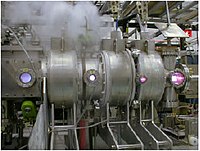Variable Specific Impulse Magnetoplasma Rocket

The Variable Specific Impulse Magnetoplasma Rocket (VASIMR) is an electro-magnetic thruster for spacecraft propulsion. It uses radio waves to ionize a propellant and magnetic fields to accelerate the resulting plasma to generate thrust.
The method of heating plasma used in VASIMR was originally developed as a result of research into nuclear fusion. VASIMR is intended to bridge the gap between high-thrust, low-specific impulse propulsion systems and low-thrust, high-specific impulse systems. VASIMR is capable of functioning in either mode. Scientist and former astronaut Franklin Chang-Diaz created the VASIMR concept and has been working on its development since 1979.
Performance
Current VASIMR designs should be capable of producing specific impulses ranging from 3,000 to 30,000 seconds (jet velocities 30 to 300 km/s). The low end of this range is comparable to some ion thruster designs. By adjusting the manner of plasma production and plasma heating, a VASIMR can control the specific impulse and thrust. VASIMR is also capable of processing much higher power levels (megawatts) than existing ion thruster electric propulsion designs. Therefore it can provide orders of magnitude higher thrust, provided a suitable power source.

Applications
VASIMR is not suitable to launch payloads from the surface of the Earth due to its low thrust to weight ratio and its need of a vacuum to operate. Instead, it will function as an upper stage for cargo, reducing the fuel requirements for in-space transportation. The engine is expected to perform the following functions at a fraction of the cost of chemical technologies:
- drag compensation for space stations.
- lunar cargo transport.
- in-space refueling.
- in space resource recovery.
- ultra high speed transportation for deep space missions.
Other applications for VASIMR such as rapid transportation of people to Mars requires a very high power, low mass energy source, such as nuclear.
In August of 2008, Tim Glover, Ad Astra director of development, has publicly stated that the first expected application of VASIMR engine is "hauling things [non-human cargo] from low-Earth orbit to low-lunar orbit" supporting NASA's return to Moon efforts.[1]
Current development
The principal developer of the VASIMR has been the Ad Astra Rocket Company. Currently, efforts have been focused on improving the overall efficiency of the engine by scaling up power levels. According to company's data, current VASIMR efficiency is at 67%. Published data on VX50 engine, capable of processing 50kW total radio frequency power, shows efficiency to be 59% calculated as: 90% NA ion generation efficiency * 65% NB ion speed boosting efficiency. Model VX100 is expected to have overall efficiency of 72% by improving the NB ion speed boosting efficiency to 80%.[2] [3] There are, however, additional (smaller) inefficiency losses related to DC electric current conversion to radio frequency power and superconducting magnets' energy consumption. By comparison current state of the art, proven ion engines designs like NASA's HiPEP operate at 80% total thruster/PPU energy efficiency.[4] Published test data on VASIMR engine model VX50 show it to be capable of 0.5N thrust. The Ad Astra Rocket Company plans to test a ground prototype rocket in early 2008, the VX-200 rated at 200kW total radio frequency power, to demonstrate the required efficiency, thrust and specific impulse.
Negotiations have taken place with NASA to arrange the placement and testing of a flight version of the VASIMR, the VF-200, on the ISS. Its launch is expected to be in 2011-2012.[5][6][7]
On October 24th, 2008 the company has announced that plasma generation part of VX-200 engine: helicon first stage or solid state high frequency power transmitter, has reached operational status. The helicon discharge uses 30 kWe of radio waves to turn Argon gas into plasma. The remaining 170kWe power is allocated for passing energy to and acceleration of plasma in the second part of the engine via ion cyclotron resonance heating.[8] Assuming expected ion boosting efficiently of 80%, at low end of the throttle VX-200 will be capable of producing 9,24N of thrust (at 3,000 isp) and in high efficiency mode it can be expected to produce less than 1N of thrust (at 30,000 isp).[2]
References
- ^ "Plasma Rocket May Be Tested at Space Station".
- ^ a b "Recent Improvements In Ionization Costs And Ion Cyclotron Heating Efficiency In The VASIMR Engine" (PDF).
- ^ "High Power VASIMR Experiments" (PDF).
- ^ "An Overview of the High Power Electric Propulsion (HiPEP) Project" (PDF).
- ^ "NASA to test plasma engine on space station".
- ^ "Plasma Rocket May Be Tested at Space Station".
- ^ "Commercially Developed Plasma Engine Soon to be Tested in Space".
- ^ "Press Release: VASIMR™ VX-200 first stage achieves full power rating" (PDF).
Additional resources
- Reuters (2007-08-14). "Plasma rocket breaks endurance record". NewScientist.com. Retrieved 2008-01-18.
{{cite news}}:|author=has generic name (help); Check date values in:|date=(help) - "Agreement to Commercialize Advanced NASA Rocket Concept; Former Astronaut Franklin-Chang Diaz to Lead Effort" (Press release). Johnson Space Center via Spaceref.com. 2006-01-23. Retrieved 2008-01-18.
{{cite press release}}: Check date values in:|date=(help); Italic or bold markup not allowed in:|publisher=(help)
External links
- NASA documents
